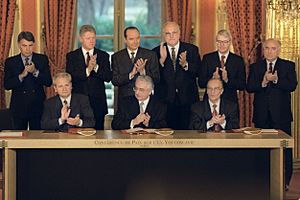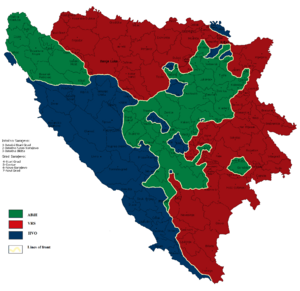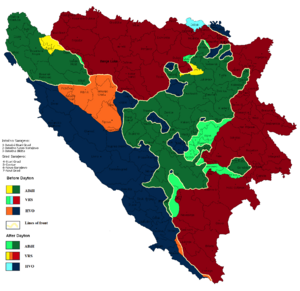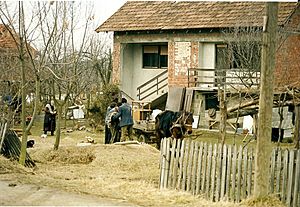Dayton Agreement facts for kids
| General Framework Agreement for Peace in Bosnia and Herzegovina | |
|---|---|
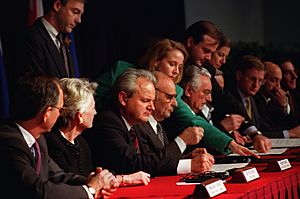
Seated from left to right: Slobodan Milošević, Alija Izetbegović, Franjo Tuđman initialling the Dayton Peace Accords at the Wright-Patterson Air Force Base on 21 November 1995.
|
|
| Drafted | 10 August 1995 |
| Signed | 14 December 1995 |
| Location | Wright-Patterson Air Force Base, Dayton, Ohio, U.S. |
| Signatories | |
| Parties |
|
| Language | English |
The Dayton Agreement, also known as the Dayton Accords, is a very important peace deal. It was reached at Wright-Patterson Air Force Base near Dayton, Ohio, in the United States, on November 21, 1995. This agreement was officially signed in Paris, France, on December 14, 1995. Its main goal was to end the Bosnian War, which had lasted for three and a half years. This war was part of the bigger Yugoslav Wars.
The groups fighting in the war agreed to stop fighting and create a single country called Bosnia and Herzegovina. This new country would have two main parts:
- Republika Srpska, mostly home to Serb people.
- Federation of Bosnia and Herzegovina, mostly home to Croat and Bosniak people.
Some people have said that the agreement created political systems that were not very effective. They also felt it made the separation of ethnic groups from the war permanent.
Contents
How the Peace Deal Was Made
Starting the Talks
Ideas for the Dayton Agreement had been discussed since 1992. However, serious talks began after earlier peace efforts failed. Also, a big military action by Croatia in August 1995, called Operation Storm, and NATO's Operation Deliberate Force helped push for new negotiations.
In September and October 1995, powerful countries like the United States and Russia worked together. They formed a group called the Contact Group. This group put pressure on the leaders of the three fighting sides to meet and talk about peace. Eventually, Dayton, Ohio, was chosen as the meeting place.
Key Negotiators
The United States played a big role in getting the talks started. A team led by National Security Adviser Anthony Lake visited European capitals in August 1995. Then, Assistant Secretary of State Richard Holbrooke took over. He traveled between the Balkan capitals, talking to leaders. His team had five intense rounds of talks from August to October. These talks led to agreements on basic peace principles in September.
The main peace conference happened in Dayton from November 1 to 21, 1995. The key leaders from the region were:
- Slobodan Milošević, President of Serbia. He represented the Bosnian Serbs.
- Franjo Tuđman, President of Croatia.
- Alija Izetbegović, President of Bosnia and Herzegovina.
US Secretary of State Warren Christopher and negotiator Richard Holbrooke led the conference. They had help from Carl Bildt (EU) and Igor Ivanov (Russia). General Wesley Clark was also a key person in the US team.
Why Dayton Was Chosen
The secure location in Dayton was chosen for several reasons. It took all the leaders away from their usual places. This made them more likely to focus on negotiations. It also made it harder for them to talk to the media. This helped prevent early news leaks that could cause problems.
After the agreement was first agreed upon in Dayton, Ohio, on November 21, 1995, it was formally signed. This happened in Paris, France, on December 14, 1995. Many world leaders witnessed the signing. These included US President Bill Clinton and French President Jacques Chirac.
What the Agreement Included
Goals of the Agreement
The main goal of the Dayton Agreement was to bring peace and stability to Bosnia and Herzegovina. It also aimed to create a balance in the region around the former Yugoslavia.
The agreement set up the current political divisions of Bosnia and Herzegovina. It also created its government structure. This was all part of the new constitution for Bosnia and Herzegovina. A very important part was drawing the Inter-Entity Boundary Line. This line divided the country into two main parts.
A Unified State
The agreement stated that Bosnia and Herzegovina would be a single, complete country. It was not just a loose group of states. This meant that no part of the country could leave unless it followed strict legal rules. Even though the two parts (Federation of Bosnia and Herzegovina and Republika Srpska) had a lot of power, there would still be a central government. This central government would have a rotating presidency, a central bank, and a constitutional court.
International Help
The agreement also asked many international groups to help. Their job was to watch over and make sure the agreement was followed.
- The IFOR (Implementation Force), led by NATO, was in charge of military tasks. They arrived on December 20, 1995.
- The Office of the High Representative was responsible for civil tasks. This included helping with government and daily life.
- The Organization for Security and Co-operation in Europe (OSCE) helped organize the first free elections in 1996.
Changes to Land Control
The Dayton Agreement changed how land was controlled in Bosnia and Herzegovina. Before the agreement:
- Bosnian Serbs controlled about 46% of the land.
- Bosniaks controlled about 28% of the land.
- Bosnian Croats controlled about 25% of the land.
After the agreement:
- Bosnian Serbs gained some mountainous areas. Their control grew to about 49% of the land. However, they had to give up Sarajevo and some important areas in eastern Bosnia.
- Bosniaks gained most of Sarajevo and some key areas in eastern Bosnia. They lost only a few small places. Their control grew to about 30% of the land. The quality of the land they controlled improved.
- Bosnian Croats gave up a lot of land, about 4% of Bosnia and Herzegovina's total area. After Dayton, they controlled about 21% of the land. Some important areas for Bosnian Croats, like parts of Posavina, were not under their control.
See also
 In Spanish: Acuerdos de Dayton para niños
In Spanish: Acuerdos de Dayton para niños
- Washington Agreement
- Peace plans offered before and during the Bosnian War
- Erdut Agreement


